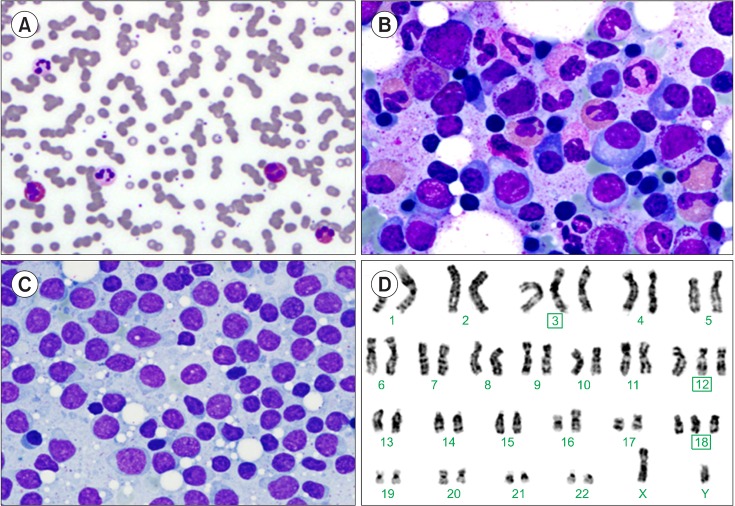
A 73-year-old man with a history of diabetes and hypertension was referred to our hospital on suspicion of multiple myeloma. On admission, a complete blood count indicated the following: Hb, 8.5 g/dL; platelets, 206.0×109/L; and WBC, 9.23×109/L. The differential counts obtained were as follows: segmented neutrophils, 51%; lymphocytes, 21%; monocytes, 8%; eosinophils, 18%; and atypical lymphocytes, 2%. Blood chemistry tests yielded the following results: calcium, 9.3 mg/dL; total protein, 11.3 g/dL; albumin, 4.5 g/dL; and BUN/creatinine, 79/4.8 mg/dL. Serum protein electrophoresis and immunofixation revealed a monoclonal peak of IgM and kappa light chain type. Peripheral blood smear shows both rouleaux formation and eosinophilia (A). Bone marrow (BM) aspirate indicates an increased number of plasma cells (18.8%) and eosinophils (9.4%) among the nucleated cells (B). Other BM fields locally show monotonous lymphoplasmacytic infiltration predominantly of small lymphocytes admixed with plasma cells and plasmacytoid lymphocytes (C). Lymphocytic cells express B-cell associated antigens (CD19, CD20) with kappa-restricted pattern on surface Ig analysis. Chromosome analysis of 20 metaphase cells indicates concurrent trisomy 3, 12, and 18 in 5 cells (D). The patient was diagnosed with eosinophilia associated Waldenstrom's macroglobulinemia (WM). To our knowledge, WM accompanied by eosinophilia and cytogenetic abnormalities has not been reported in the literature.




 PDF
PDF ePub
ePub Citation
Citation Print
Print


 XML Download
XML Download